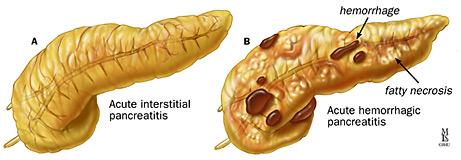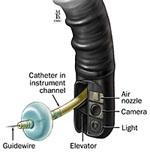Acute Pancreatitis
Pancreatitis is an inflammation of the pancreas. The pancreas produces juices that help digest food in the small intestine. It also produces insulin, which controls the sugar level in your blood.

Acute Pancreatitis Symptoms
The main symptom of acute pancreatitis is mild to severe abdominal pain. Patients with acute pancreatitis also have elevated pancreatic enzymes, which show up in blood and urine tests.
Other symptoms include:
-
Nausea and vomiting
-
Respiratory failure
-
Confusion
-
Fever
-
Mild jaundice
Acute Pancreatitis Diagnosis
A diagnosis of pancreatitis begins with a comprehensive physical exam during which you describe your symptoms and medical history. Tests your doctor may order include:
-
Laboratory Testing
-
Imaging Scans
-
Endoscopic Retrograde Cholangiopancreatography (ERCP)
-
ERCP with Sphincter of Oddi Manometry
Laboratory Testing
During an acute pancreatitis attack, the pancreas releases enzymes into the blood. Measuring these enzymes is helpful in diagnosing acute pancreatitis. Blood and urine tests look for the presence of these enzymes. The most common enzymes measured are amylase and lipase.
Imaging Scans for Pancreatitis
If you have severe abdominal pain, we may recommend an imaging study. Imaging studies use various different technologies to obtain enhanced, detailed pictures of your body. These studies will reveal an obstruction, fluid buildup, or an increased separation between your stomach and colon. These findings suggest an inflammation of the pancreas.
Imaging studies used to diagnose acute pancreatitis include:
-
Ultrasound uses sound waves to create detailed images. It is not sensitive enough to detect pancreatic abnormalities, but it is useful in detecting gallstones and other obstructions. Computed tomography (CT) scan is a powerful X-ray and the best
-
diagnostic test for acute pancreatitis. Your doctor may perform a contrast-enhanced CT scan because the contrast highlights any abnormalities.

Endoscopic Retrograde Cholangiopancreatography (ERCP)
An ERCP is an endoscopic technique that allows for visualization of the bile and pancreatic ducts. During this procedure, a special side-viewing endoscope is inserted into the duodenum.
This endoscope, called a duodenoscope, is specially designed to ease placement of endoscopic accessories into the bile and pancreatic ducts. Your doctor will also inject a dye into the ducts to obtain detailed X-ray images.
ERCP is a sensitive and specific diagnostic test for acute pancreatitis. It shows details of your pancreatic anatomy, including any strictures (narrowed areas), ruptures and cysts.
ERCP and Sphincter of Oddi Manometry
The sphincter of Oddi is a muscle that controls the flow of bile and pancreatic juices. Sphincter of Oddi manometry is a diagnostic procedure that allows your doctor to determine whether the sphincter is opening and closing normally.
Treatment Acute Pancreatitis Treatment
Treatment for acute pancreatitis allows the pancreas to rest and recover from the inflammation.





